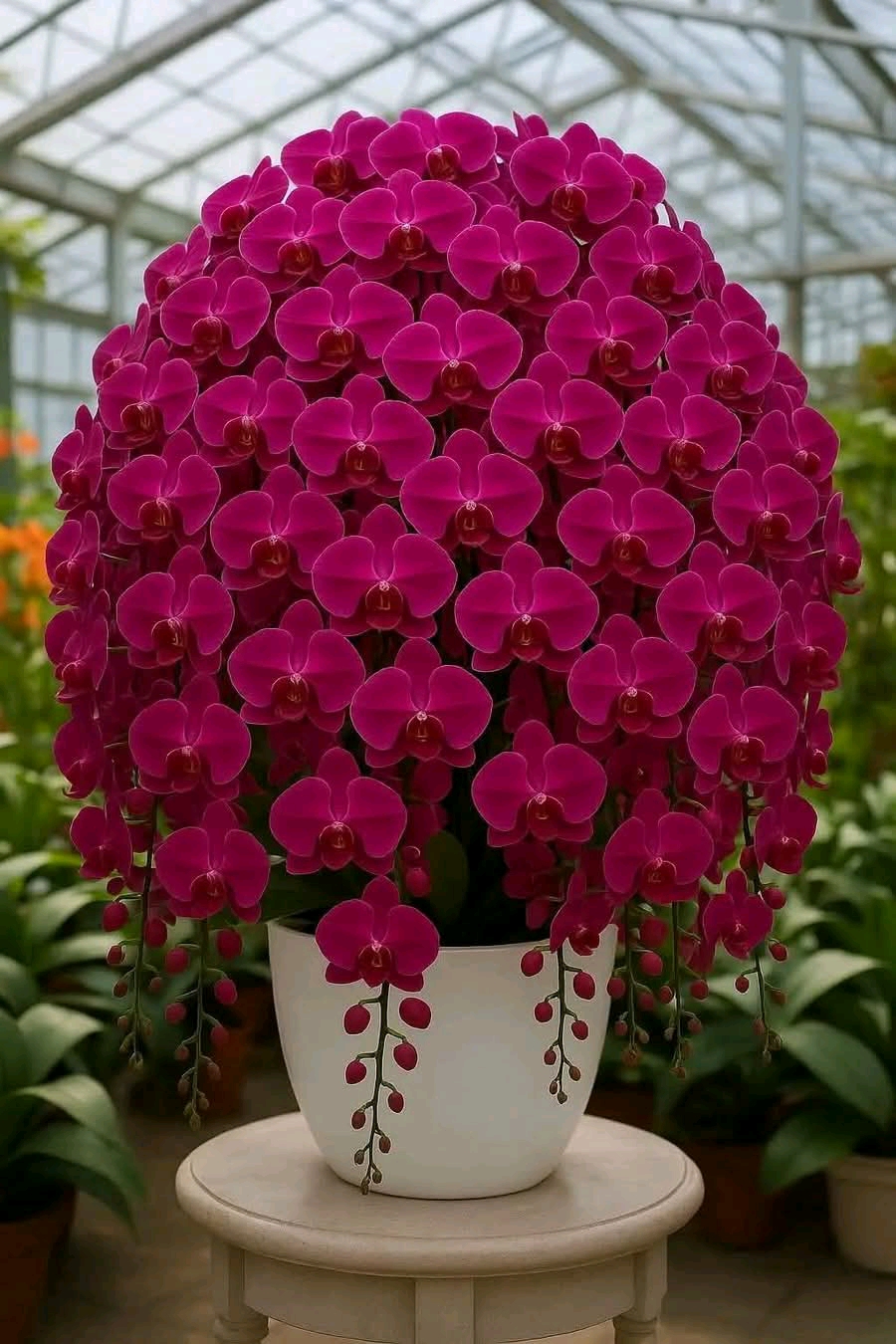Few flowers embody elegance quite like the Phalaenopsis orchid, and the striking magenta variety showcased in the image above is an absolute showstopper. With cascading blooms in rich jewel tones and perfect symmetry, this orchid doesn’t just brighten a room—it commands attention. Whether placed in a greenhouse, conservatory, or living room, magenta Phalaenopsis orchids add an exotic, luxurious charm to any setting.
In this blog post, we’ll explore everything you need to know about these dazzling flowers—from what makes them special to how to care for them and even how to get them to rebloom year after year.
🌸 What Makes Magenta Phalaenopsis Orchids So Special?
Phalaenopsis orchids, commonly known as moth orchids, are among the most popular orchids grown worldwide. Their name comes from their resemblance to moths in flight, especially when their blooms are in full glory. The magenta variant, in particular, stands out for its:
Vibrant, saturated color that symbolizes admiration, grace, and luxury.
Masses of blooms that form a dome of color when grown in optimal conditions.
Long blooming period—some flowers last up to 3 months!
Ease of care, making them perfect even for beginner indoor gardeners.
These orchids are not only a treat to look at but also carry cultural symbolism. In many traditions, orchids are associated with refinement, strength, and rare beauty.
🌿 Growing Conditions for Phalaenopsis Orchids
While Phalaenopsis orchids are relatively easy to grow, getting those lush, full heads of cascading flowers like the one in the image takes attention to detail. Here’s how to make it happen:
☀️ Light
Bright, indirect sunlight is key.
East-facing windows are ideal, or filtered light through sheer curtains.
Avoid direct midday sun, which can scorch the delicate leaves.
🌡️ Temperature
Orchids prefer temperatures between 65°F and 80°F (18–27°C).
At night, temperatures can drop slightly—this helps initiate blooming.
Avoid placing them near cold drafts or heating vents.
💧 Watering
Water only when the potting medium is nearly dry.
Overwatering is the #1 killer of orchids!
Use tepid water and water thoroughly, allowing excess to drain out completely.
Never let the roots sit in standing water.
💦 Humidity
These orchids thrive in high humidity—ideally 50–70%.
Use a humidity tray, room humidifier, or group plants together.
Mist occasionally if the air is dry, especially in winter.
🪴 Potting Medium
Use a mix specifically designed for orchids—typically bark, perlite, and sphagnum moss.
Avoid regular potting soil—it retains too much moisture and leads to root rot.
🌱 Repotting
Repot every 1-2 years, or when the medium breaks down.
Choose a slightly larger pot with ample drainage holes.
Gently remove old roots and dead material during repotting.
🌼 Fertilizing for Maximum Blooms
Magenta Phalaenopsis orchids bloom best when they’re given the right nutrients. During the active growing season (spring to fall), feed your orchid with a balanced, water-soluble fertilizer (like 20-20-20 or orchid-specific blends) every 2-4 weeks.
Reduce fertilizing in the winter months when growth naturally slows.
Pro Tip: Water your orchid first before applying fertilizer to avoid root burn.
🌸 Encouraging Reblooming
If your orchid has finished blooming and you’re wondering how to coax it into flowering again:
Cut the spent flower spike just above a node (joint)—a new bloom may emerge.
If the stem has turned brown or shriveled, cut it down to the base.
Move the plant to a slightly cooler room at night for several weeks—this can stimulate a new spike.
Patience is key! With the right care, Phalaenopsis orchids will reward you with new blooms every year.
🌺 Styling and Display Ideas
A blooming magenta Phalaenopsis orchid is a living work of art. Here are a few ideas for showing off its beauty:
Place it on a pedestal or plant stand to give it center stage (just like in the image!).
Use white or neutral-colored pots to make the blooms pop.
Add moss or pebbles to the base of the pot for a polished look.
Group with other orchids for a dramatic floral statement in larger spaces.
They also make excellent gifts for birthdays, anniversaries, and housewarmings—symbolizing love, admiration, and success.
⚠️ Common Mistakes to Avoid
Even the most beautiful orchids can suffer if not cared for properly. Watch out for:
Overwatering – The most common error. Always check the potting medium.
Insufficient light – Leads to weak growth and lack of blooms.
Dry air – Causes bud drop and browning leaf tips.
Neglecting to repot – Old medium holds too much water and starves the roots of air.
🌸 Final Thoughts
Magenta Phalaenopsis orchids are the crown jewels of the orchid world—bold, exotic, and surprisingly easy to care for with the right knowledge. Whether you’re a plant enthusiast or just starting your indoor gardening journey, adding one of these beauties to your home will bring elegance and a touch of the tropics to your everyday life.
So why not bring home a magenta orchid and let it bloom its way into your heart?
More Articles You Might like
-
Texas Toast Sloppy Joes: The Crunchy, Cheesy Upgrade You Didn’t Know You Needed
There’s something timeless about sloppy joes. For generations, this saucy, savory, and slightly sweet ground beef sandwich has been a go-to comfort food in American kitchens. It’s quick, filling, and family-friendly—perfect for busy weeknights. But what if we told you there’s a way to take this classic dish up a notch? Enter the Texas Toast…
-
Classic Pig Pickin’ Cake
When it comes to Southern desserts, few sweets shine as brightly as the Classic Pig Pickin’ Cake. This nostalgic cake, sometimes called a “Mandarin Orange Cake,” has roots deep in Southern tradition. It gets its playful name from its frequent appearance at pig pickin’s—Southern-style barbecue gatherings where communities come together to enjoy slow-cooked pork, sides,…
-
Lemon Garlic Butter Chicken with Creamy Parmesan Pasta
There’s something irresistible about the combination of tender, golden-browned chicken paired with a creamy pasta coated in Parmesan cheese. Add the brightness of lemon, the depth of garlic, and the richness of butter, and you have a recipe that feels indulgent yet approachable enough for a weeknight dinner. Lemon Garlic Butter Chicken with Creamy Parmesan…



